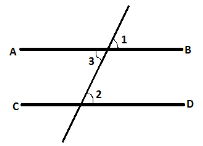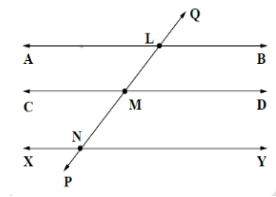Answer
424.8k+ views
Hint: Here in this question some properties of parallel lines will get used which are being mentioned below with the help of a diagram.

Alternate angles. ($\angle 3 = \angle 2$ )
Corresponding angles. ($\angle 1 = \angle 2$ )
Vertical opposite angles. ($\angle 1 = \angle 3$)
Complete step-by-step answer:

Suppose three lines are there naming AB, CD and XY. Two lines AB and XY are parallel to CD. So we have to prove that they are parallel to each other also. For this we will draw a transversal line PQ such that it cuts AB at point L, CD at point M and XY at point N.
$AB\parallel CD$ and PQ is a transversal line.
$\therefore \angle BLM = \angle DMP$ (Corresponding angles) ....................equation 1.
$XY\parallel CD$ and PQ is a transversal line.
$\therefore \angle YNP = \angle DMP$ (Corresponding angles) ...................equation 2.
From equation 1 and 2 we get that $\angle BLM = \angle YNP$
Therefore from the reverse statement of property of parallel lines which states that if two lines are parallel then corresponding angles are equal similarly when corresponding angles are equal then the lines through which angles are there will be parallel.
$AB$ is parallel to $XY$
The given statement is true.
Note: Students may find little confusion in determining corresponding and alternate angles so in hint basic diagram which is mentioned must be remembered.
Alternate method for this question: -
$AB\parallel CD$ and PQ is a transversal line.
$\therefore \angle ALM = \angle CMN$ (Corresponding angles) ....................equation 1.
$XY\parallel CD$and PQ is a transversal line.
$\therefore \angle XNP = \angle CMN$ (Corresponding angles) ...................equation 2.
From equation 1 and 2 we get that $\angle ALM = \angle XNP$
Therefore from the reverse statement of property of parallel lines which states that if two lines are parallel then corresponding angles are equal similarly when corresponding angles are equal then the lines through which angles are there will be parallel.
$\therefore AB\parallel XY$

Alternate angles. ($\angle 3 = \angle 2$ )
Corresponding angles. ($\angle 1 = \angle 2$ )
Vertical opposite angles. ($\angle 1 = \angle 3$)
Complete step-by-step answer:

Suppose three lines are there naming AB, CD and XY. Two lines AB and XY are parallel to CD. So we have to prove that they are parallel to each other also. For this we will draw a transversal line PQ such that it cuts AB at point L, CD at point M and XY at point N.
$AB\parallel CD$ and PQ is a transversal line.
$\therefore \angle BLM = \angle DMP$ (Corresponding angles) ....................equation 1.
$XY\parallel CD$ and PQ is a transversal line.
$\therefore \angle YNP = \angle DMP$ (Corresponding angles) ...................equation 2.
From equation 1 and 2 we get that $\angle BLM = \angle YNP$
Therefore from the reverse statement of property of parallel lines which states that if two lines are parallel then corresponding angles are equal similarly when corresponding angles are equal then the lines through which angles are there will be parallel.
$AB$ is parallel to $XY$
The given statement is true.
Note: Students may find little confusion in determining corresponding and alternate angles so in hint basic diagram which is mentioned must be remembered.
Alternate method for this question: -
$AB\parallel CD$ and PQ is a transversal line.
$\therefore \angle ALM = \angle CMN$ (Corresponding angles) ....................equation 1.
$XY\parallel CD$and PQ is a transversal line.
$\therefore \angle XNP = \angle CMN$ (Corresponding angles) ...................equation 2.
From equation 1 and 2 we get that $\angle ALM = \angle XNP$
Therefore from the reverse statement of property of parallel lines which states that if two lines are parallel then corresponding angles are equal similarly when corresponding angles are equal then the lines through which angles are there will be parallel.
$\therefore AB\parallel XY$
Recently Updated Pages
How many sigma and pi bonds are present in HCequiv class 11 chemistry CBSE

Why Are Noble Gases NonReactive class 11 chemistry CBSE

Let X and Y be the sets of all positive divisors of class 11 maths CBSE

Let x and y be 2 real numbers which satisfy the equations class 11 maths CBSE

Let x 4log 2sqrt 9k 1 + 7 and y dfrac132log 2sqrt5 class 11 maths CBSE

Let x22ax+b20 and x22bx+a20 be two equations Then the class 11 maths CBSE

Trending doubts
Fill the blanks with the suitable prepositions 1 The class 9 english CBSE

At which age domestication of animals started A Neolithic class 11 social science CBSE

Which are the Top 10 Largest Countries of the World?

Give 10 examples for herbs , shrubs , climbers , creepers

Difference between Prokaryotic cell and Eukaryotic class 11 biology CBSE

Difference Between Plant Cell and Animal Cell

Write a letter to the principal requesting him to grant class 10 english CBSE

Change the following sentences into negative and interrogative class 10 english CBSE

Fill in the blanks A 1 lakh ten thousand B 1 million class 9 maths CBSE



